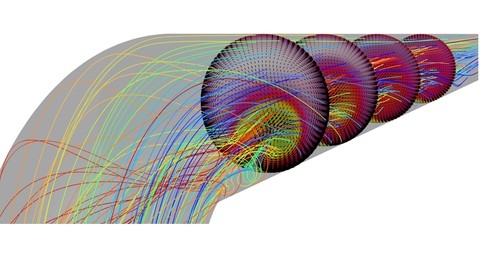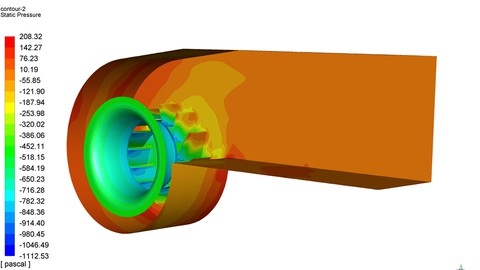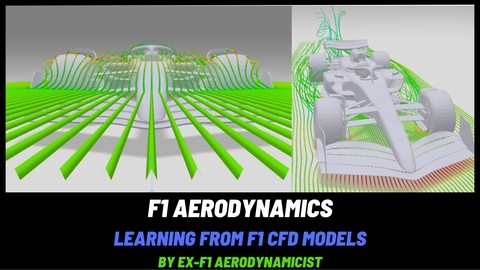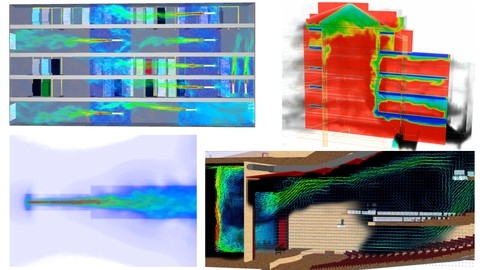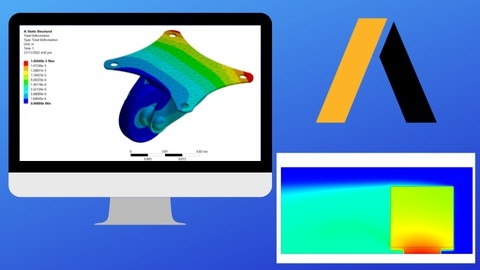Computational Fluid Dynamics (CFD) is a powerful tool used by engineers to analyze and predict fluid flow behavior.
It involves simulating fluid motion, heat transfer, and other physical phenomena using mathematical equations and numerical methods.
By mastering CFD, you can optimize designs, improve efficiency, and solve complex engineering problems in fields like aerospace, automotive, and energy.
Finding a high-quality CFD course on Udemy can be a daunting task, especially if you are new to the subject.
You’re looking for a course that provides a solid theoretical foundation, practical applications, and engaging lessons, all delivered by experienced instructors.
After reviewing countless CFD courses on Udemy, we recommend Mastering ANSYS CFD as the best course overall.
This comprehensive program guides you through the entire process, from setting up simulations to analyzing results.
You’ll learn to use both CFX and Fluent solvers, explore advanced techniques like turbulence modeling, and gain practical experience tackling real-world problems.
This is just one of the many great CFD courses available on Udemy.
Keep reading for more recommendations tailored to different levels, specific software, and areas of interest, so you can find the perfect course to take your CFD skills to the next level.
Mastering ANSYS CFD
This comprehensive course is your gateway to mastering ANSYS CFD, a powerful suite of tools for analyzing fluid flow.
You’ll embark on a journey that starts with the fundamentals, guiding you through the creation of geometry, mesh generation, and setting up boundary conditions.
The course then dives deeper into practical applications, using real-world examples like laminar pipe flow and the analysis of a NACA 0012 airfoil to illustrate key principles.
You’ll become proficient in using both CFX and Fluent solvers, gaining hands-on experience with tools like CFX Pre for setting up simulations and CFD-Post for visualizing and analyzing results.
The course doesn’t shy away from advanced techniques like turbulence modeling, mesh independence studies, and even fluid structure interaction (FSI), equipping you with the skills to tackle complex engineering challenges.
Prepare to explore a vast range of applications, from simulating mixing elbows and cooling towers to analyzing tank emptying scenarios.
You’ll gain expertise in handling challenging problems like simulating flow separation in a 90-degree bend and determining the Nusselt number for turbulent pipe flow.
This course isn’t just about learning software; it’s about gaining a deep understanding of fluid dynamics principles and applying them to real-world problems.
CFD of External Aerodynamics and Turbomachinery
You’ll gain practical experience tackling real-world problems, moving beyond theoretical concepts and into the realm of application of CFD.
The course starts with the fundamentals, guiding you through boundary layer theory, mesh generation, and geometry processing in Spaceclaim.
You’ll learn to clean up CAD models, create fluid domains, and master the art of generating high-quality tetrahedral and prism meshes.
As you progress, you’ll delve into the complexities of turbomachinery CFD modeling.
This section explores different approaches like frozen rotor, mixing plane, and sliding mesh models, allowing you to analyze rotating machinery with accuracy and precision.
Throughout the course, you’ll tackle fascinating real-world challenges.
For example, you’ll simulate flow around an Ahmed Body, a P3C Orion aircraft, and even a tulip turbine.
This hands-on experience will teach you how to set up boundary conditions, choose appropriate turbulence models, and interpret your results.
Beyond these standard CFD applications, you’ll also explore the analysis of a high-rise building for wind loads and model a generic mixing tank.
This variety ensures you gain a well-rounded understanding of CFD’s diverse applications.
You’ll have a strong grasp of CFD principles, practical experience with industry-standard software, and the ability to analyze complex simulations, drawing valuable insights from your findings.
Computational Fluid Dynamics Fundamentals Course
This course dives straight into the heart of the matter, starting with transport equations, the fundamental language of describing fluid flow.
You’ll gain a deep understanding of the diffusion equation, a crucial model for understanding how properties like heat and mass spread through a fluid.
The course then moves on to the convection-diffusion equation, which adds the complexity of fluid motion to the diffusion process.
One of the strengths of this course is its clear explanation of upwind differencing, a technique essential for accurately approximating solutions to these equations using computers.
You’ll gain hands-on experience with this technique, which is key for applying CFD principles in real-world scenarios.
The inclusion of a comprehensive quiz ensures you solidify your understanding of the key concepts covered throughout the course.
This assessment serves as a valuable tool for reinforcing your learning and identifying areas that require further review.
While this course is a great starting point, consider exploring more specialized courses or resources to delve deeper into specific areas of CFD that align with your interests.
Computational Fluid Dynamics Fundamentals Course 2
This course provides a solid foundation in Computational Fluid Dynamics (CFD), starting with the fundamentals and progressing to practical applications.
You’ll begin by mastering the crucial concepts of Dirichlet and Neumann Boundary Conditions, which are essential for understanding how fluids behave at the edges of a defined space.
The course then delves into Transport Equations, the mathematical tools that describe how properties like momentum and heat are transferred within fluids.
You’ll gain hands-on experience applying these equations in two dimensions through a detailed worked example.
Wall Functions, which play a vital role in simulating fluid flow near solid surfaces, are also covered in detail.
A dedicated worked example will help you solidify your understanding of this important concept.
Computational Fluid Dynamics (CFD) for Professionals
This CFD course is a practical introduction to the key concepts and techniques you need to perform accurate and reliable simulations.
You’ll dive straight into the core elements of validation and verification, learning how to refine your mesh and ensure the accuracy of your calculations.
Mastering the art of turbulence modeling, you’ll gain the skills to capture the complexities of fluid flow in your simulations.
The course emphasizes the importance of experimental data, guiding you through the process of finding and analyzing real-world observations to validate your simulation results.
You’ll then learn to present your findings in a clear and professional manner, mastering the creation of contour plots for visualizing your data, line plots for displaying trends, and results tables for summarizing your simulation outcomes.
Throughout the course, you’ll work through a series of exercises that provide hands-on experience and solidify your understanding of the concepts.
The course culminates in a short quiz to test your grasp of these essential concepts and ensure you’re ready to apply your newfound skills in real-world projects.
This course is ideal for beginners looking to gain a solid foundation in CFD principles and practices.
Computational Fluid Dynamics Fundamentals Course 3
This course, Computational Fluid Dynamics Fundamentals Course 3, is a solid introduction to the world of unstructured mesh methods.
You’ll start with a clear overview of the course’s structure and then dive right into the heart of finite volume discretization.
This method is crucial for breaking down complex fluid flow problems into manageable chunks, allowing for accurate simulations.
You’ll explore mesh generation techniques, a key aspect of setting up your simulations, and then move on to the fascinating topic of mesh quality.
Here, you’ll learn about essential metrics like aspect ratio, Jacobian determinant, and skewness, all crucial for ensuring accurate results.
You’ll learn how these metrics affect your simulations and gain practical experience using Python code and Excel spreadsheets to analyze and manipulate them.
The course’s strength lies in its clear explanation of these fundamental concepts and its hands-on approach.
You’ll work through specific example problems like heat diffusion in a 2D plate, gaining practical experience in implementing the techniques you’ve learned.
It’s well-suited for those who want a practical, hands-on learning experience in this critical field.
ANSYS from Drawing to Results Visualization - CFD and FEA
This comprehensive course delves into the power of ANSYS, a software essential for anyone involved in computational fluid dynamics (CFD) and finite element analysis (FEA).
You’ll learn to take your designs from initial sketches to sophisticated simulations that mirror real-world conditions.
The course starts with a strong foundation, introducing core concepts like numerical solving methods and strategies for tackling engineering problems.
You’ll then dive headfirst into the heart of ANSYS, exploring its versatility in solving a wide range of problems and mastering its powerful solvers.
To enhance visualization, you’ll even learn to craft your own figures and schematics using PowerPoint and Adobe Illustrator, a valuable skill for communicating complex ideas effectively.
DesignModeler, a key component of ANSYS, takes center stage next.
This module equips you with the skills to create intricate 3D models.
You’ll learn to draw lines, surfaces, and solid bodies, and utilize tools like extrude, revolve, sweep, and loft to build your designs.
The course also covers essential techniques for refining and repairing your geometry, crucial steps for ensuring accurate simulations.
The world of meshing awaits in the subsequent module, where you’ll divide your models into smaller pieces to generate a mesh.
You’ll explore various meshing methods, including tetrahedrons and hex dominant, and discover how to create high-quality meshes that faithfully represent your models.
This module also delves into important concepts like mesh quality, mesh dependency testing, and mesh sizing, all of which play a vital role in achieving reliable simulation results.
The final stages of the course provide hands-on experience through a series of practical projects.
These projects demonstrate how to utilize ANSYS to simulate real-world scenarios.
You’ll learn to analyze heat conduction in a linear apparatus, determine the critical radius of insulation for a cylinder, and even simulate fluid flow over a heated flat plate.
This practical experience will solidify your understanding of CFD and FEA, empowering you to confidently apply ANSYS to solve your own engineering challenges.
F1 Aerodynamics : Basics with F1 CFD Models & Jobs in F1
Are you ready to dive deep into the fascinating world of F1 aerodynamics?
This course, “F1 Aerodynamics: Basics with F1 CFD Models & Jobs in F1,” offers a unique combination of real-world insights, technical expertise, and practical guidance.
You’ll begin by hearing firsthand from a former Red Bull Aerodynamics engineer, gaining a unique perspective on the inner workings of a top-tier F1 team.
This insider’s look provides invaluable context for understanding the demands of an aerodynamicist’s role, the importance of flow field analysis, and the intricate relationship between downforce and lap time.
Then, you’ll dive headfirst into the technical aspects of F1 aerodynamics.
You’ll learn to visualize flow fields around an F1 car, analyze the downforce distribution on different components, and understand the key factors that influence downforce generation.
You’ll even get to explore real-world CFD case studies, comparing the designs of the 2023 Aston Martin AMR 23 and Mercedes W14 cars, and analyzing the impact of different aerodynamic philosophies.
The course also delves into the crucial role of F1 floors and their interaction with rear wings.
You’ll gain an in-depth understanding of the Red Bull RB19 floor design and the effectiveness of triple DRS systems.
You’ll also explore practical aspects like the function of winglets and how to land a job in the competitive world of Formula One.
Drawing on the speaker’s own experience, you’ll receive valuable tips on crafting an effective CV and cover letter, and how to confidently prepare for F1-related interviews.
This comprehensive course culminates with a truly unique benefit – access to a 2023 specification F1 car model in Solidworks.
This hands-on resource allows you to put your newly acquired knowledge into practice, build your own simulations, and solidify your understanding of complex aerodynamic concepts.
This course effectively blends theory with practice, making it a valuable resource for anyone seeking to enter the exciting world of F1 aerodynamics.
You’ll gain a deep understanding of the principles, practical tools, and valuable advice to embark on a successful career in this thrilling field.
Mastering Fire Dynamics Simulation (FDS - CFD) Using Pyrosim
If you’re seeking to master the intricacies of computational fluid dynamics (CFD) as applied to fire dynamics, “Mastering Fire Dynamics Simulation (FDS - CFD) Using Pyrosim” offers a comprehensive and practical learning experience.
This course utilizes Pyrosim, a powerful software that leverages the Fire Dynamics Simulator (FDS) to model fire behavior in diverse scenarios, giving you the tools to tackle complex fire safety analysis.
You’ll begin by diving into the fundamentals of Pyrosim, gaining a solid understanding of the software’s interface and navigating its features with confidence.
The course guides you through the process of constructing models within Pyrosim, using both basic and advanced geometric techniques.
This includes defining crucial elements such as materials, surfaces, fire sources, and even pressure zones, enabling you to create increasingly complex simulations.
You’ll also learn to define HVAC systems and incorporate control logics for more sophisticated modeling.
The course progresses to cover meshing techniques, ensuring you can create accurate models with proper resolution for reliable results.
You’ll explore the intricacies of defining simulation outputs, choosing the right data to collect, including temperature, velocity, and smoke distribution.
Finally, you’ll gain hands-on experience running FDS simulations and analyzing the results using SmokeView post-processing software.
This course provides a solid foundation for those seeking to utilize CFD for fire safety analysis and advanced simulation techniques.
FEA & CFD with ANSYS Mechanical & ANSYS Fluent- For Beginner
This course effectively covers both the theoretical foundations and practical applications of these powerful computational tools.
You’ll begin by exploring the fundamental principles of the Finite Element Method, diving into the theory behind it and examining the various types of elements used.
The course then guides you through the ANSYS Workbench interface, teaching you how to navigate the software, create custom materials, and seamlessly import designs from other CAD packages.
A strong emphasis is placed on mastering the art of meshing, ensuring your models are accurately prepared for analysis.
Throughout the course, you’ll gain hands-on experience with a range of analysis types, including static structural analysis, thermal analysis, modal analysis, buckling analysis, and electric analysis.
You’ll apply your newfound knowledge to real-world examples, such as analyzing stresses in a cantilever beam or understanding the thermal behavior of a heat sink.
The curriculum even delves into advanced concepts like topology optimization, enabling you to design lightweight structures while maintaining structural integrity.
The course then transitions smoothly into the realm of CFD, teaching you how to simulate fluid flow using ANSYS Fluent.
You’ll start with simple laminar flow in a pipe scenarios and progress to more complex problems like conjugate heat transfer analysis and analyzing fluid-solid interaction.
While the course provides a solid foundation, it is important to note that further exploration and practice are essential for becoming a proficient FEA and CFD practitioner.
